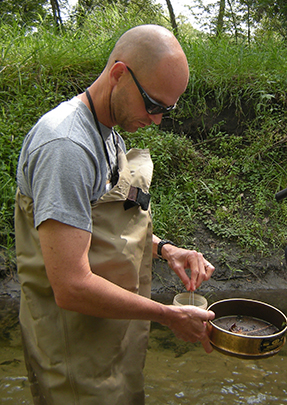40 species of beetles documented for first time in Iowa

“This publication is the product of more than two decades of bioassessment work in the state, and a comprehensive review and verification of numerous historical records,” said Mike Schueller, laboratory environmental manager, Limnology program. “Todd’s work is unprecedented as a valuable functional and historical resource for the distribution of aquatic beetles in Iowa.”
The Coleopterists Bulletin, a peer-reviewed journal in entomology, accepted Hubbard’s paper for its September edition. Though listed as the sole author, Hubbard is quick to point out that the work includes contributions by many others.
Woven into the paper is an extensive literature review and scientific research that goes back to the early 1900s. It also represents many individual collections, including those at the National Museum of Natural History in Washington, D.C., the Smithsonian Biodiversity Institute and Natural History Museum, University of Kansas, University of Oklahoma and Luther College, in addition to Hubbard’s own collection.
Building the database of aquatic beetles has been a steady accumulation of research since 1994, two years after Hubbard joined the Hygienic Lab as a limnologist. In that same year, the Iowa Department of Natural Resources began its Ambient Biological Monitoring Program to monitor the biological communities of rivers and streams throughout the state. This includes the environmental health projects conducted by the State Hygienic Laboratory.
To determine species, scientists like Hubbard use systematic and identification resources known as keys. Prior to Hubbard’s paper, there was limited documentation of aquatic beetles in Iowa, leaving researchers to look outside the state for resources that sometimes were inadequate. Hubbard hopes his work will fill this void.
“For anybody who works in this field, it’s laborious trying to figure out distributional information, and when we do a lot of the identification work, we’re relying on keys, and a lot of them are regional keys and not specific to Iowa,” Hubbard said.
“It’s just really helpful to have these biogeographic papers that essentially give you an idea about where these particular species have spread across the continental United States. And for me, I rely on them a lot. And if papers like these are present, then it makes my job a lot easier and everybody else’s taxonomic work a lot easier, too. Going forward, this paper and others like it will help future researchers.”
Among a very few
Limnology is a specialized field of science. Unlike most other states, the Hygienic Laboratory has a specific limnology department that focuses on assessing biological criteria on a statewide basis. These limnologists are among the very few taxonomic experts in the Midwest who identify, describe and classify organisms.
Much of this happens outdoors, year around. Limnologists sometimes work in subzero temperatures and 90-degree-plus heat to begin the process of accessing the health of surface water and the impact of human activity on it.
Dressed in chest-high waders and boots – and winter gear when the weather dictates – limnologists collect samples of water from many of the more than 200 waterways in Iowa. These samples are tested in the lab for the presence of nitrates, bacteria, pesticides and other contaminants. Test results and measurements of temperature, dissolved oxygen, pH and stream flow taken onsite give a broad view of water quality.
But these are snapshots of water quality at the point in time when the collections and measurements were made. It is the “critters” that live in waterways that give a more holistic picture of environmental health. Are species of fish and benthic macroinvertebrates over-populating or under-represented? Are there critters in the streams that shouldn’t be? Is there evidence of invasive species?
“Each of them is almost like a piece of a puzzle,” Hubbard said. “They can provide you a little more comprehensive summary, especially when coupled with other invertebrates that we collected. It tells you just a little piece of what’s going on out there.”
‘…the better we all are’
It’s not unusual for publications and museums – including the Smithsonian and the National Museum of Natural History – to contact the Hygienic Lab’s Limnology group for photos and information about their unique catalog. Other entomologists and biologists are invited to submit species to the existing Limnology database.
“We keep adding more species from all different orders of insects and non-insects to our database. It’s continually expanding,” Hubbard said. “And then we also do some individual collections and we also have side projects.
“All that stuff just kind of adds to what we’ve collected. Our goal is to just make this evident to people who are interested, and it’s possible because the more they know about the natural heritage and what’s present, then the better we all are.”
As for Coleoptera, Hubbard says that there are many species in Iowa that still need to be identified, particularly in ponds, which are not part of the Hygienic Laboratory limnology section monitoring program.
“The value of this is that there’s a lot more life out there than maybe people necessarily recognize,” he said. “And I think it’s important to document what’s present because you don’t know what you’ve lost if you don’t know what’s there.
“And hopefully we’re not in a situation where we’re losing things, but I think it’s important to know what’s lived there because a lot of things like this – way in the past – we wouldn’t have even known what to call them. The taxonomy associated with a lot of these species 150 years ago wasn’t really present. And some of it’s changed a lot, and our understanding of the species concept is always changing.
“I think it’s important to document what we have. Future generations will have this information and know that at least in the late ‘90s into 2000s, this is what was collected in Iowa and it was collected from these locations. I think it’s useful in that respect.”



